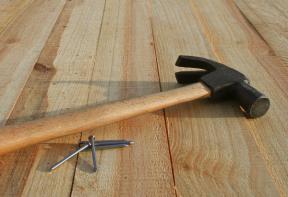Hammer basics
The original hand tool
Every year there’s a new type of hammer for sale, promising to be the ultimate nail driver. It seems to me hammers are similar to golf clubs; choosing one depends on the situation at hand and, like golf, how you swing the club is just as important as what you swing. Always grasp the hammer near the end of the handle. Here are some tips:
– Don’t strangle the grip or choke up.
– Treat it like an extension of your arm and let the weight of the hammer do the work. – Face the nail so it’s right in front of your striking shoulder and swing with a full arc, raising the tool from the shoulder and elbow-not the wrist.
– Relaxing your wrist absorbs the impact of the blow.
– To start a nail, hold it near its head so that you don’t crush your fingers if you miss, keeping your eye on the nail (not the hammer) just as you’d keep your eye on the ball….
Before buying a hammer, be sure it feels balanced and comfortable in your hand and that it fits your needs. Here are six different types. (clockwise from top left)
1. Titanium: this tool combines an exchangeable striking face with a lightweight titanium head and a fibreglass shaft that flexes as you swing.
2. Wooden mallet: necessary for most woodworking projects, especially for hitting chisels.
3. Cabinetmaker’s hammer: the cross peen helps you start nails while the round, slightly belled face lets you drive nails without marring the surrounding wood.
4. Nailing hammer: this features a grooved head with nail slots to help set up nails.
5. Claw hammer: everyone needs this basic, 16-oz. hammer. Straight claws are better for prying and curved ones for pulling nails.
6. Tack hammer: great for tiny tacks and nails or when working with really delicate materials like fingers.

To leave a comment, please log in












No comments